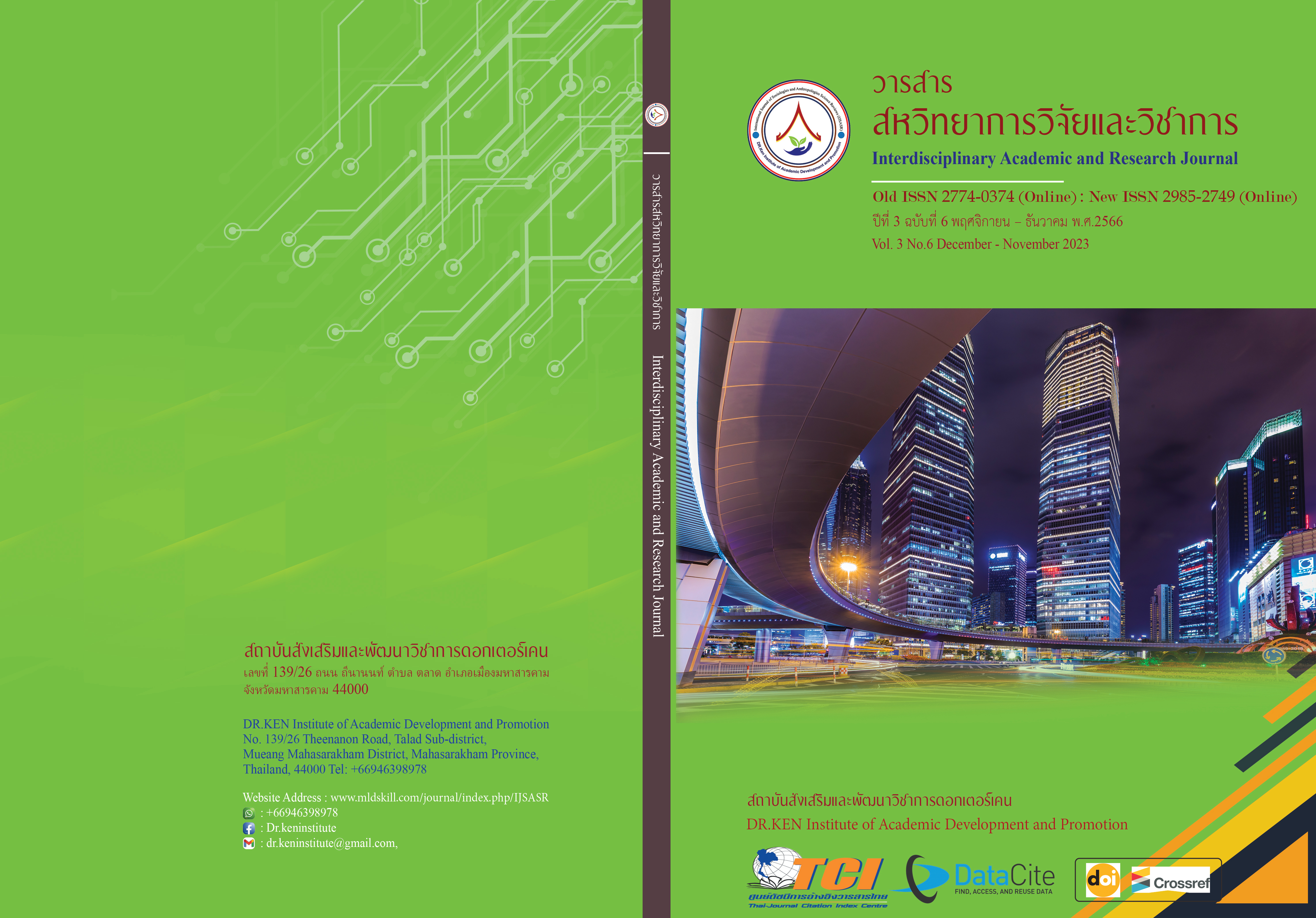Community Enterprises with Poverty Problems Solving in Ubon Ratchathani Province: A Case Study of Khao Mao Group Community Enterprises of Ban Kham Lai, Trakan Phuet Phon District, Ubon Ratchathani Province
DOI:
https://doi.org/10.60027/iarj.2023.272768Keywords:
Operation; , Community Enterprises;, Khao Mao Group of Ban Kham Lai;, Poverty Problems SolvingAbstract
Background and Aims: Forming groups into community enterprises is a solution to solving the economic problems of people in the community. It is a sustainable solution that creates direct results in the community, such as developing careers, reducing production costs, developing product quality, creating added value for crops or natural resources available in the local area, creating cost-effective returns, responding to the needs of consumers in the community and outside the community. Thus, the objective of this research was to study the operating conditions of community enterprises with community poverty problems in Ubon Ratchathani Province which was the case study of Khao Mao Group Community Enterprises of Ban Kham Lai, Trakan Phuet Phon District, Ubon Ratchathani Province.
Methodology: This was qualitative research, the research tools were interview questions. The participants in this research were 20 members of Khao Mao Group Community Enterprises of Ban Kham Lai, Kam Charoen Sub-district, Trakan Phuet Phon District. The statistical used to analyze the data was content analysis.
Results: In terms of activities, the production and selling of Khao Mao by community enterprise members were ongoing. There were orders from regular customers who regularly ordered Khao Mao products. The sales value of Khao Mao products tended to increase every year which caused Khao Mao group community enterprises members of Ban Kham Lai to have extra money besides farming. Despite being affected by the flood situation in Ubon Ratchathani province in 2022, the Khao Mao production of Khao Mao Group Community Enterprises of Ban Kham Lai was still popular. Guidelines for the operation of community enterprises to solve poverty problems in Ubon Ratchathani Province A case study of the Khao Mao Ban Kham Lai community enterprise. Will adhere to the principle of member participation. The members had a sense of ownership of the community enterprise organization and adhered to the principle of member participation as a guideline for operations. Guidelines for developing community enterprises of Ban Kham Lai’s Khao Mao Group Community Enterprises included promoting skills in product production, adding value to products, packaging development, and digital marketing skills.
Conclusion: The community enterprise of Khum Khrai Lao's glutinous rice in Ubon Ratchathani province continues to operate efficiently in both production and distribution of glutinous rice. There is a consistent demand from regular customers, and the sales of glutinous rice show an increasing trend every year. Despite facing the impact of flooding in the province during certain periods, glutinous rice products remain popular in the market. In addressing the community's poverty issues, the community enterprise focuses on fostering member participation and a sense of ownership. The emphasis is on developing production skills, increasing the value of products, packaging development, and digital marketing skills to sustainably drive the local economy and yield effective results.
References
กรมส่งเสริมการเกษตร.(2562). คู่มือจดทะเบียนวิสาหกิจชุมชนและเครือข่ายวิสาหกิจชุมชน. กรุงเทพฯ: กองส่งเสริมวิสาหกิจชุมชน กรมส่งเสริมการเกษตร.
กิ่งกาญจน์ สิงหเนตรวัฒน์.(2554). กลยุทธ์การตลาดผลิตภัณฑ์ข้าวเม่าอาหารเช้าของกลุ่มวิสาหกิจชุมชนบ้านน้ำอ้อม อำเภอเกษตรวิสัย จังหวัดร้อยเอ็ด. วิทยานิพนธ์มหาบัณฑิต,มหาวิทยาลัยขอนแก่น.
จักรพันธ์ จันทร์หอม และภัทรธิรา ผลงาม. (2562). การวิจัยและพัฒนาคุณภาพผลิตภัณฑ์ชุมชนในกลุ่มแม่บ้านเกษตรกรบ้านสว่างธรรมวิเศษ ตำบลน้ำอ้อม อำเภอเกษตรวิสัย จังหวัดร้อยเอ็ด. วารสารบัณฑิตศึกษามหาจุฬาขอนแก่น. 6(1), 276-288.
พรรณภา พรหมชิณวงศ์. (2547). การวิเคราะห์ศักยภาพในการผลิตและการตลาดข้าวเม่าและผลิตภัณฑ์: กรณศึกษากลุ่มแม่บ้านเกษตรกรน้ำอ้อม อำเภอเกษตรวิสัย จังหวัดร้อยเอ็ดปี 2546. กรุงเทพฯ: มหาวิทยาลัยเกษตรศาสตร์. 2547.
ราชบัณฑิตยสถาน. (2554). พจนานุกรม ฉบับราชบัณฑิตยสถาน พ.ศ.2554. กรุงเทพฯ: นานมีบุคส์.
วิทยา อธิปอนันต์. (2549). วิสาหกิจชุมชนเสริมสร้างกระบวนการแก้ไขความยากจน. กรุงเทพฯ: กรมส่งเสริมการเกษตร.
ศิริจารีย์ จันทร์ลา. (2565). การดำเนินงานของวิสาหกิจชุมชนกลุ่มข้าวเม่าบ้านคำไหล ตำบลคำเจริญ อำเภอตระการพืชผล จังหวัดอุบลราชธานี. สัมภาษณ์เมื่อ 7 ธันวาคม 2565
สรรเพชร เพียรจัด, จตุพัฒน์ สมัปปิโต, จินตนา วัชรโพธิกร และจารินี ม้าแก้ว. (2564). รูปแบบการยกระดับเศรษฐกิจชุมชนด้วยการพัฒนาผลิตภัณฑ์อัตลักษณ์พื้นถิ่นข้าวเม่า แบบบูรณาการ อำเภอนางรอง จังหวัดบุรีรัมย์. วารสารวิชาการ มจร บุรีรัมย์. 6(1), 105 -119.
สำนักงานคณะกรรมการกฤษฎีกา. (2548). พระราชบัญญัติส่งเสริมวิสาหกิจชุมชน พ.ศ. 2548. ราชกิจจานุเบกษา เล่ม 112/ตอนที่ 6 ก/หน้า 1/18 มกราคม 2548.
สำนักงานวิจัย สำนักงานนายกรัฐมนตรี. (2562). นโยบายและแนวคิดในการแก้ไขปัญหาความยากจน. สำนักงานนายกรัฐมนตรี. Retrieved from: https://digital.car.chula.ac.th/cgi/viewcontent.cgi?article=5281&context=chulaetd
สำนักงานสถิติแห่งชาติ. (2565). สถิติการปลูกข้าวปีเพาะปลูกพ.ศ.2563 – 2564. Retrieved 18 March 2022 from: https://ittdashboard.nso.go.th/preview.php?id_project=25.
อภิญญา สุดหา. (2565). แนวทางพัฒนาสินค้าจากการแปรรูปข้าวเม่าอ่อนบ้านคำไหล ตำบลคำเจริญ อำเภอตระการพืชผล จังหวัดอุบลราชธานี. สัมภาษณ์เมื่อ 7 ธันวาคม 2565
อรทัย พึ่มกุล. (2565). ภูมิปัญญาท้องถิ่นของชุมชนบ้านคำไหล เรื่อง การทำข้าวเม่าของบ้านคำไหล อำเภอตระการพืชผล จังหวัดอุบลราชธานี. สัมภาษณ์เมื่อ 23 ธันวาคม 2565.
Banerjee, A. V., & Duflo, E. (2019). Good economics for hard times. Public Affairs.
Buratti, N., Albanese, M. and Sillig, C. (2022), "Interpreting community enterprises’ ability to survive in depleted contexts through the Humane Entrepreneurship lens: evidence from Italian rural areas", Journal of Small Business and Enterprise Development, 29 (1), 74-92. https://doi.org/10.1108/JSBED-05-2021-0167
Kunasri, K. (2020). A Study of Potential and Development of Community. Journal of Community Development Research (Humanities and Social Sciences), 13(1), 92-108.
Liguori, M. A., & Bendickson, J. S. (2016). Solving poverty: A solution-focused perspective. Journal of Poverty, 20(3), 329-346.
Majid, M. S., & Salikin, S. (2018). Reducing poverty through income generation: Theoretical and practical approaches. Journal of Social Studies Education Research, 9(1), 232-250.
Martin, M., & Leger, L. (2017). The effectiveness of microfinance loans on the level of poverty in the developing countries. European Research Studies Journal, 20(1), 267-283.
Peredo, A. M. (2006). Toward a Theory of Community-Based Enterprise. Journal of Developmental Entrepreneurship, 11(3), 213-229.
Reza, F., & Ahmadi, A. (2019). Poverty alleviation and development in Iran: A multidimensional approach. Iranian Economic Review, 23(1), 93-109.
Downloads
Published
How to Cite
Issue
Section
License
Copyright (c) 2023 Chuthamas Chompha, Waikoon Krongyuth

This work is licensed under a Creative Commons Attribution-NonCommercial-NoDerivatives 4.0 International License.
Copyright on any article in the Interdisciplinary Academic and Research Journal is retained by the author(s) under the under the Creative Commons Attribution-NonCommercial-NoDerivatives 4.0 International License. Permission to use text, content, images, etc. of publication. Any user to read, download, copy, distribute, print, search, or link to the full texts of articles, crawl them for indexing, pass them as data to software, or use them for any other lawful purpose. But do not use it for commercial use or with the intent to benefit any business.
















.png)


